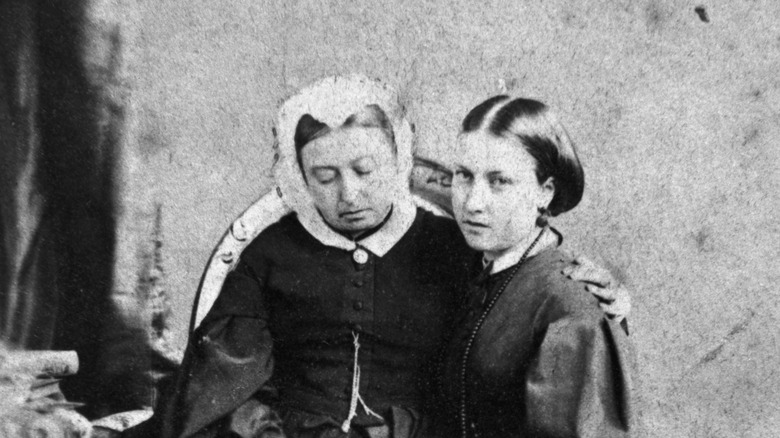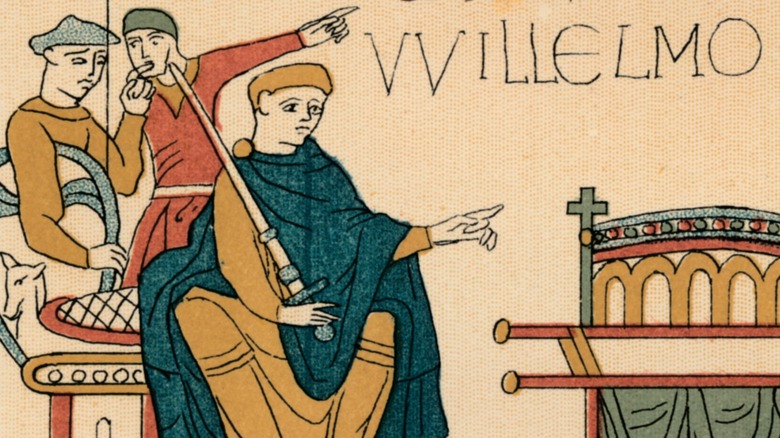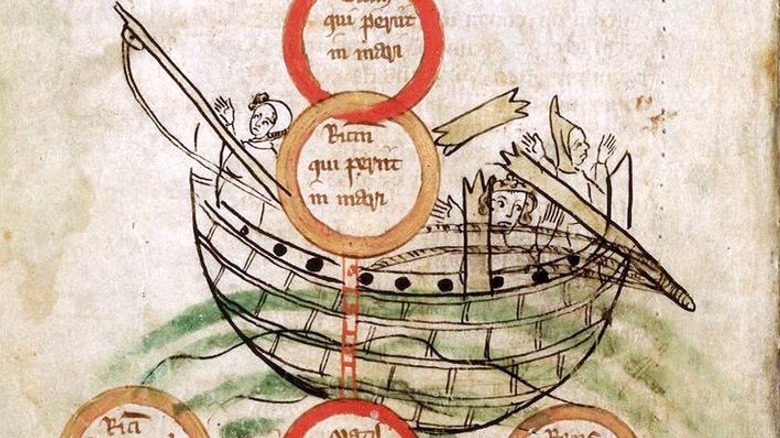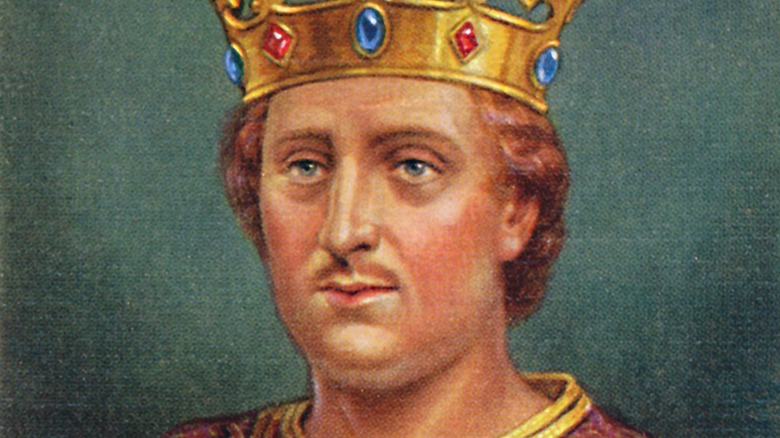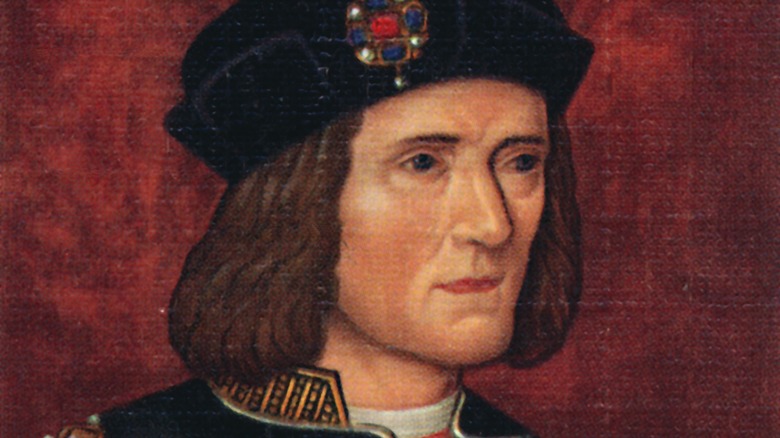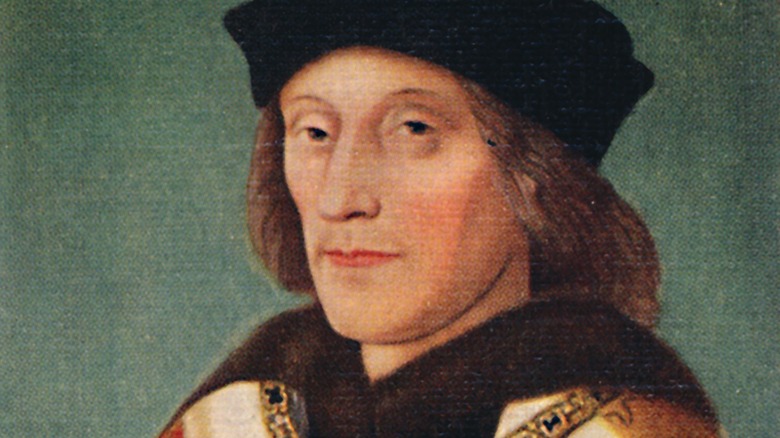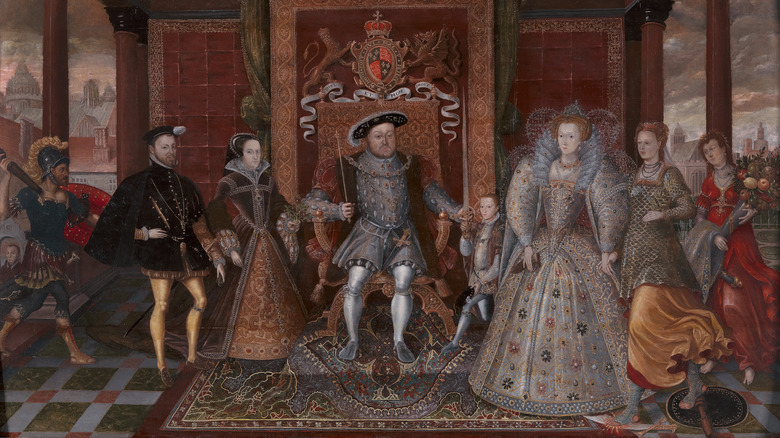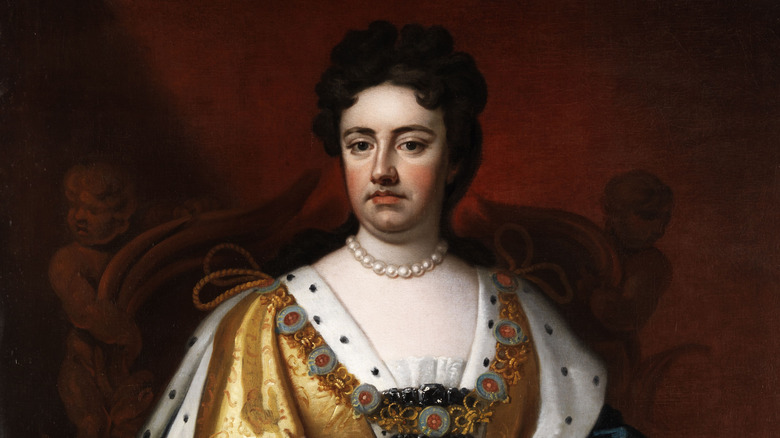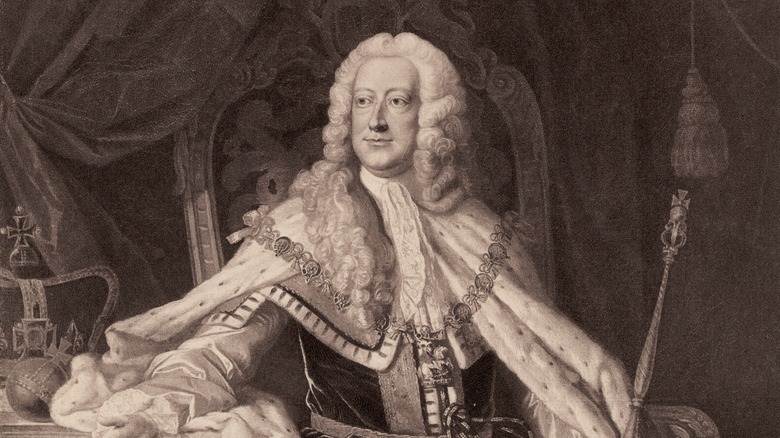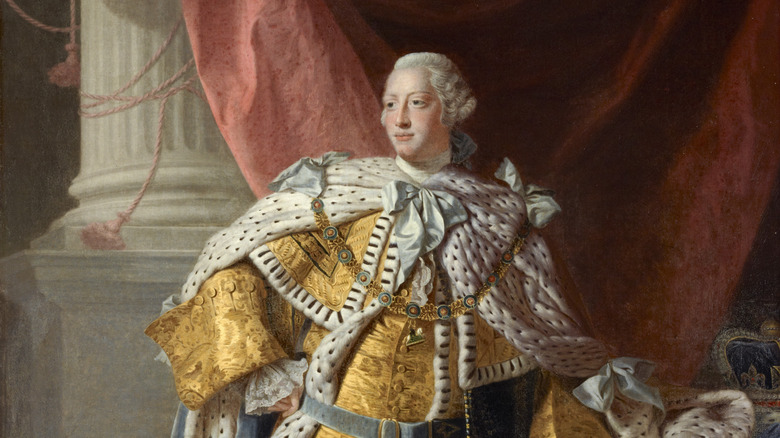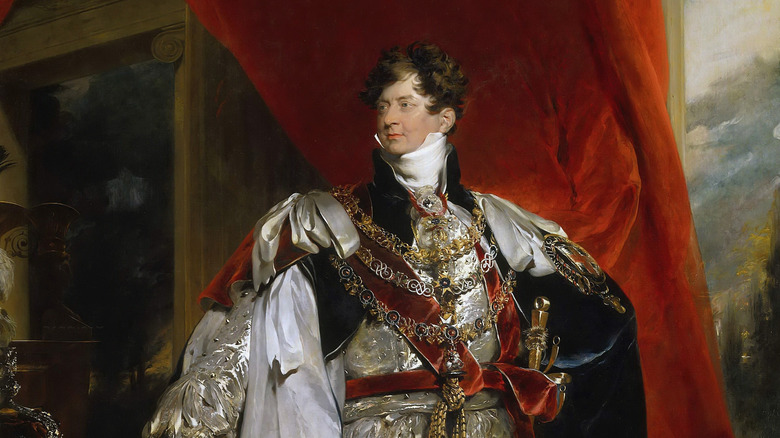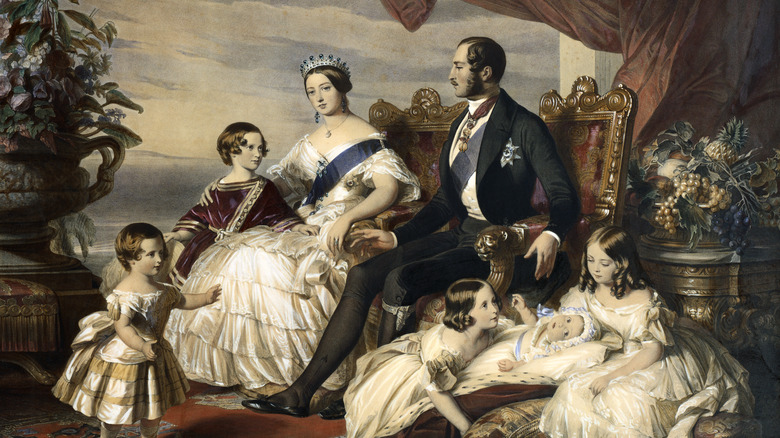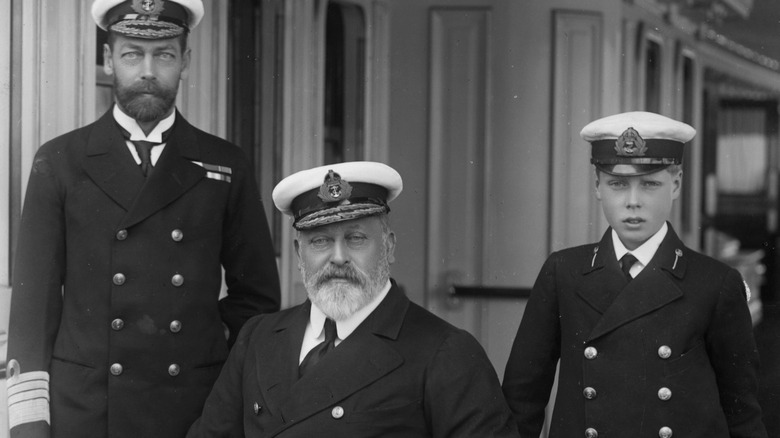British Kings And Queens Who Outlived Their Children
Because of how the British monarchy works, it's almost required that the king or queen has a child that can one day take their place on the throne. While the crown can pass sideways to siblings or even cousins if it has to, the preferred tradition is for a child to inherit the role from their parent. For most of British history, it was also considered important that this child was a boy, however, girls would work in a pinch. Most queens, if they were physically able, gave birth to several children, and some more than a dozen. A large brood meant that even with the high mortality rate of the past 1,000 years, there would always be a child remaining to take over when the time came.
However, said high mortality rate meant that many British kings and queens ended up living longer than one, several, or even all of their children. This could result in not just a personal tragedy, but a dynastic one as well. Even the loss of, say, a fifth daughter could be politically disastrous if she was supposed to make an important alliance through her marriage. Here are some of the monarchs who weathered all those problems and more when they lost their children before their time.
William the Conqueror
William the Conqueror was a French duke who famously invaded England in 1066 and defeated King Harold at the Battle of Hastings, taking the crown for himself. The next 21 years were spent making sure he held on to it, as the English were not always happy about being ruled by a foreigner. There were a series of rebellions that William I generally crushed with an iron fist.
But there were more personal issues to deal with as well after William conquered England. He and his wife Matilda had five sons and four daughters, but, sadly, one of them would not make it to adulthood. Only a few years after William invaded, his second-born son Richard died. The exact date of his death is unknown, but records show he was alive in 1069, so the tragedy is usually dated to around 1070, although it could have been as late as 1075. Richard is thought to have been born around 1055, so he would have been a teenager when he went to the woods to hunt on that fateful day. While it's not completely clear what killed him, some accounts suggest he was riding along and hit his head against a branch.
While Richard is William I's only known child to have predeceased the king, another son of William's actually died in very similar circumstances to Richard: William II, who inherited the crown from his father, died after being shot with an arrow in a hunting accident.
Henry I
William II was shot and died while out hunting in 1100. Because he had no children, the crown of England went to his younger brother Henry, who became Henry I. Unlike William, Henry had lots of children, although only two or three of them were legitimate. And a single disaster would take two of those out of the world forever, eventually leading to a civil war in England.
According to the chronicler Ordericus Vitalis in "The Ecclesiastical History of England and Normandy," which was written contemporaneously to the event, in 1120, Henry's heir William Adelin and his brother Richard (who may or may not have been legitimate, depending on the source) were crossing the English Channel in the Blanche-Nef or White Ship. Vitalis claims that the crew of the vessel was drunk, and they made several dumb mistakes while sailing, which eventually led to the boat crashing into a rock and sinking. He says 300 people were on board, and all but one of them died, including William Adelin and Richard. (In an interesting modern royal connection, Princess Diana's brother wrote a book about the White Ship, and in 2021 was part of an expedition to try to find it.)
This left Henry with only one surviving legitimate child, but that one presented almost as much of a problem as his dead sons: She was a girl. When Henry died, his daughter Matilda was challenged for the throne by her cousin Stephen.
Henry II
In the battle for the English crown, Stephen came out on top and eventually made his rival, Matilda's son, Henry, his heir. In 1154, he came to the throne as Henry II. While Henry would live to see three of his children buried, he honestly might have wished it had been more of them because they were really into rebelling against him.
Henry II's heir was called Henry the Young King because he'd been crowned a sort of co-ruler in 1170. But rather than appreciate this, Henry the Young King raised a rebellion against his dad only a few years later. The rebellion failed — as did the one Henry the Young King waged against his brother Richard. It was during this conflict that he died of dysentery. The Young King was joined in both his rebellions by his brother Geoffrey, who would also die before their father in the year 1186, although sources disagree on if he died in a jousting tournament or due to a medical issue.
It's not clear if Henry II's daughter, also named Matilda, died before him or not, but it was extremely close either way. Both died in 1189; Henry on July 6 while warring against his son Richard. Matilda's death date is not known exactly but was sometime in June or July.
Richard III
Richard III was immortalized as a bad guy by several famous writers of Tudor times, most famously William Shakespeare, but it's generally accepted now that this was unfair propaganda. While Richard had his faults, he was portrayed as a monster more because he was the guy Henry VII defeated to become king of England than anything based on reality.
It's true that Richard only became king after several relatives with better claims to the throne died or disappeared (as the famous Princes in the Tower did), but that doesn't mean he was responsible for those events. It did mean that his rule was shakier than he'd like, so he put a lot of emphasis on his only child, Edward of Middleham. Having an heir made him look like he had his dynasty all ready to go. Edward was born somewhere between 1473 and 1477, and, for whatever reason, his parents were unable to have any more children. His life became even more precious once his father was king, when he gave his son the title Prince of Wales and made the lords pledge their loyalty to the young boy.
However, all the political maneuvering in the world couldn't save the boy from illness. Richard hadn't even been on the throne for a year when Edward came down with an illness and died in April of 1484.
Henry VII
Henry VII defeated Richard III at the Battle of Bosworth Field in 1485, thus beginning probably the most famous dynasty in English royal history: the Tudors. Henry VII was the father of the infamous Henry VIII, but the younger Henry was never supposed to be king. He had an older brother named Arthur, and, had the boy lived longer, English history would have been very different.
Arthur was born the year after his father won the throne, and his name reflected the great things expected of him. Once Arthur got a little older, his arranged marriage was equally grand. Henry VII intended for his son to marry the Spanish princess Catherine of Aragon. When the wedding day finally arrived after years of negotiations, it was a huge celebration. Henry VII was using his heir to cement his own position — which became a problem when Arthur died only five months after the wedding.
Catherine stayed in England in a kind of limbo after she became a young widow. It was only when Henry VII died that Arthur's brother, now Henry VIII, decided to marry his sister-in-law. At the time this probably seemed like a kind thing to do, and the two would have known each other pretty well by then, but it would be disastrous once Henry VIII wanted a male heir and used her first marriage to his brother as a reason to end his own marriage to Catherine.
Henry VIII
Henry VIII is famous for the number of wives he went through, at least partially in order to get some male heirs. In the end, he ended up with three healthy children, all of whom would sit on the throne after he died: Edward VI, Mary I, and Elizabeth I. One of the reasons Henry wanted to divorce his first wife, Catherine of Aragon, was because they had no male children. Mary wasn't considered good enough as she was only a girl.
But while only Mary lived to grow up, Catherine actually had many pregnancies over the years. However, almost all of them resulted in miscarriages and stillbirths. The longest-lived child besides Mary was Henry, Duke of Cornwall. He was born on January 1, 1511, barely a year and a half after his father became king, and the country was thrilled. Tragically, he would die weeks later, on February 22.
It is possible that one other child of Henry and Catherine's was born alive. The Venetian ambassador recorded in 1513's "Calendar of State Papers and Manuscripts, Relating to English Affairs" that "a male heir was born to the King of England and will inherit the crown, the other son having died." If the baby was alive when it was born, however, it must have died within a very short time.
Anne
Queen Anne was pregnant 17 times – once with twins — but she outlived every single one of her children. While she would not become queen until 1702, Anne found herself in a marriage arranged for dynastic reasons, wedding Prince George of Denmark in 1683. Charles II, a notorious hedonist, found George to be as boring as watching paint dry, but Anne seemed to like him, considering how regularly she was pregnant.
Many of those pregnancies ended in miscarriages or stillbirths, but several children were born alive. These included Princesses Mary and Anne Sophia, who both died of smallpox within the same week in 1687. Another Mary was born in 1690 but only lived a couple of hours. The same was true of a son, George, born in 1692.
The only child to live more than two years was William, Duke of Gloucester. Born in 1689, he looked likely to become king one day, since the then-co-regents of England William III and Mary II had no children of their own. But Anne would not even be on the throne herself before William died, aged just 11, in 1700. The modern medical consensus is that he died of pneumonia.
George II
George II and his wife Queen Caroline had eight children, but several of them would die before their father. The youngest, Louise, married the future king of Denmark and was very popular in her new country, but died from pregnancy complications in 1751. Another daughter, Princess Caroline, never married, dying three years before her father in 1757. A third daughter would predecease him by even less: Princess Anne died in 1759, the year before the king.
However, the situation with his sons was even worse. George II hated his own father, George I. In 1717, the then Prince George fathered a boy. He and Caroline picked out their favorite names and the people they wanted as godparents. But George I said their choices were wrong and that instead, the kid would also be named George. He then appointed some people the couple hated as godparents. It was a lot of drama and for nothing, since the baby George only lived for a few months before dying in early 1718.
Dynastically, the biggest blow to George II was the loss of his heir, Frederick Louis, Prince of Wales. Personally, it was not such a painful event, because the two hated each other with a passion. Queen Caroline also hated her firstborn and was said to have rejoiced on her deathbed that at least it meant she never had to look at him again. George would outlive him, though, with Frederick dying in 1751, allegedly due to an old sports injury.
George III
George III became king in 1760, at just 22, because his father had died nine years previously, and the young George inherited the crown from his grandfather George II. In a long line of arranged marriages that ranged from indifference to disasters, it is notable that George III and his wife, Queen Charlotte, were madly in love. This was reflected in many ways, the most obvious being the 15 children she gave birth to.
Prince Edward, Duke of Kent and Strathearn and father of the future Queen Victoria, only predeceased George by six days, dying of pneumonia on January 23, 1820. By then, however, George had not been in his right mind for a very long time and would not have known.
The loss of his other children was more tragic. Princess Amelia was George's youngest and favorite child, but she was unwell most of her life, suffering from tuberculosis. She finally succumbed to her illness in 1810, and her death completely destroyed her already broken father. The Princes Alfred and Octavius were still just toddlers when they both died after being inoculated against smallpox, which at the time was a dangerous treatment but worth the risk to avoid catching the horrific disease. Alfred was not yet two when he died in 1782, and Octavius was four when he died the following year.
George IV
George IV grew up with the perfect example of how to make an arranged marriage work, as his parents George III and Queen Charlotte genuinely loved each other. But when the younger George (then the Prince of Wales) finally agreed to do what was expected of him as heir to the throne and settle down with an acceptable partner, it didn't work out that way. The Prince of Wales hated his wife, or, as the British royal family's official website tactfully puts it, "the marriage was a failure."
This meant that they only managed to have one child together before they separated, and everyone accepted that Princess Charlotte would be queen one day. Once she grew up, this meant she was a very eligible woman, and after a surprisingly eventful few years of playing the field, she settled on a German suitor, Prince Leopold. They married and she quickly became pregnant. But tragically, Charlotte died giving birth to a stillborn child in 1817, after a truly agonizing two-day delivery.
While George III had many children, in the end, the next generation had a real problem producing legitimate heirs. This meant that the death of Charlotte was a disaster for the monarchy, until another brother, the Duke of Kent, finally managed to father a child, born in 1819, shortly before he died in 1820.
Victoria
The Duke of Kent's daughter, Queen Victoria came to the throne in 1837 and stayed there until the turn of the next century. She and her husband, Prince Albert, had nine children, all of whom lived to adulthood. However, being quite long-lived herself meant that the queen still buried several of her children.
Princess Alice was the third child of Queen Victoria; after her marriage, she became the Grand Duchess of Hesse. She had seven children of her own, but sadly, one of them died during a diphtheria outbreak that affected almost every member of her family. While comforting another one of her ill children, Alice caught the disease herself. She died at age 35 on December 14, 1878, which was 17 years to the day after Victoria lost her husband Albert.
While Prince Leopold's early death was tragic, it was also a miracle he lived as long as he did, since he was born with hemophilia and suffered from epilepsy. However, he managed to attend Oxford, get married, and have his own children before he died in 1884. While in France, he tripped and injured himself badly enough that his hemophilia made it impossible to recover. He was 31.
Prince Alfred, who'd entered the Navy when he was 14, died less than a year before his mother, in 1900, making it to the age of 55. He died from throat cancer.
Edward VII
Edward VII became king after his mother, Queen Victoria, died in 1901. By then, he was a relatively old man himself, less than a year from his 60th birthday. And by that time, he'd already buried two of his six children. One of them, the last child of Edward and his wife, Alexandra, was named Alexander after his mother, but tragically the baby died the day after it was born in 1871.
The couple's first child, and the heir to the throne, was Prince Albert Victor, named after both his paternal grandparents. He was in his late 20s by the time he had time to settle down, having spent the previous decade attending Cambridge, enlisting in the Army, and taking a seven-month tour of India, among other things. The woman who finally agreed to marry him was Princess Mary of Teck, and a date was blocked off in the calendar for their wedding when Albert Victor became unwell. There was a particularly bad flu pandemic at the time, and Albert Victor's case led to pneumonia, which killed him. He was 28 and died only six weeks before he was supposed to get married.
In an extremely bizarre turn of events, everyone involved decided that Princess Mary should just get hitched to the next brother, who was now in direct line to the throne. Eighteen months after her first fiance's death, Mary married his brother, Prince George, the Duke of York, who would go on to be George V.
